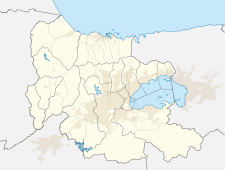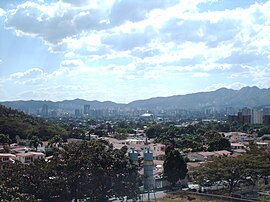Valencia (Venezuela)
| Valencia | ||
|---|---|---|
|
Coordinates: 10 ° 10 ′ N , 68 ° 0 ′ W Valencia on the map of Carabobo
|
||
| Basic data | ||
| Country | Venezuela | |
| State | Carabobo | |
| City foundation | March 25, 1555 | |
| Residents | 1,860,000 (update 2018) | |
| City insignia | ||
| Detailed data | ||
| height | 479 m | |
| City structure | 10 boroughs | |
| Waters | Lake Valencia , Rio Cabriales | |
| Post Code | 2001 - 2003 | |
| Time zone | UTC -4 | |
| City Presidency | Michele Cocchiola Pugliese | |
| Website | ||
| View in north direction | ||
Valencia is the third largest city in Venezuela and the capital of the state of Carabobo . It has 1,860,000 inhabitants (as of 2018).
geography
The city lies 479 meters above sea level in a valley that is surrounded by a mountain range of the Cordillera de Mérida , the Cordillera de la Costa . To the east of the city is Lake Valencia , Venezuela's second largest lake into which the Cabriales flows. This also flows through the city. The distance to the capital Caracas is 180 km.
history
Already in the 4th millennium BC There were peoples who lived in this region as hunters and gatherers . They were probably already farming . Between 200 and 1000 AD there was an important settlement in the region, especially around Lake Valencia.
Around 1000 AD, immigrants from the Orinoco region came to the region, probably via the Pao River .
On March 25, 1555, the Spanish captain Alonso Díaz Moreno founded the city. The official name was "Nuestra Señora de la Asunción de Nueva Valencia del Rey". In the colonial period, Valencia played an important role due to its good access to the Llanos pasture and competed with Caracas for supremacy in the region until the 19th century.
The conquistador Aguirre besieged the city in 1561. In 1677 it was attacked by French pirates , the city center burned down and many important documents about Venezuela's early settlement were destroyed.
The German explorer Alexander von Humboldt visited Valencia on his trip through South America in 1800 and reported a population of six to seven thousand.
Venezuela has been a Spanish colony since the occupation by the Spanish . In 1811, Valencia was declared the capital of the first Republic of Venezuela. In 1813 the city was surrounded by Spanish troops led by Boves and occupied after a long battle. Men were executed en masse, most women raped. On June 24, 1821, the troops of Simón Bolívar fighting for Venezuela's independence, 29 km south of Valencia, won a decisive victory over the Spaniards in the Battle of Carabobo .
In 1830, Valencia became the capital of Venezuela for a short time after a country assembly here declared the country's independence from Greater Colombia . In 1858 the city was again temporarily the capital of the country. In 1922 Pope Pius XI. Valencia to the seat of a diocese he founded , which was elevated to a metropolitan archbishopric in 1974 .
In the 20th century, the city experienced rapid growth from the 1940s , largely influenced by oil production and the subsequent industrialization in the region. Many immigrants from other regions of Venezuela, but also from all over the world, come to Valencia. Between 1945 and 1970 there were mainly Europeans, then many South Americans (especially Colombians, Ecuadorians and Peruvians), but also Lebanese, Chinese and others. The crime rate rose sharply in the 1990s .
At least 68 people were killed on March 28, 2018 as a result of a prisoner riot in a city police station. Many of the inmates and visitors killed were burned in a fire that was created by lighting mattresses. Because of the overcrowding in Venezuelan prisons, detainees are increasingly being placed in police station cells, where the law does not allow them to stay longer than 48 hours.
City structure
Valencia has the following parroquias (municipal districts):
| local community | Population estimate 2005 |
|---|---|
| Parroquia Urbana Candelaria | 25,858 |
| Parroquia Urbana Catedral | 2.223 |
| Parroquia Urbana El Socorro | 5,484 |
| Parroquia Urbana Miguel Peña | 428.831 |
| Parroquia Urbana Rafael Urdaneta | 250.609 |
| Parroquia Urbana San Blas | 22,634 |
| Parroquia Urbana San José | 141,423 |
| Parroquia Urbana Santa Rosa | 71,760 |
In addition, Valencia has merged with Naguanagua , San Diego and parts of Los Guayos .
The city is administered by the mayor's office (executive) and seven councilors from the local parliament (legislative).
education
Valencia has a public university , the Universidad de Carabobo . There are also a number of private universities, such as B. the Universidad Arturo Michelena in San Diego and the Universidad José Antonio Paez.
Culture
Museums
- Casa Paez: former home of Antonio José Paez, now a museum
- Museo de Arte e Historia (also called Casa Celis)
- Museo de Historia y Antropología: This museum contains numerous findings from Indian cultures, as well as objects from later times.
- Museo de la Cultura: many exhibitions take place here.
Art centers
- Ateneo de Valencia: The Ateneo de Valencia was closed for a long time and is now reopening. There are exhibitions and plays, but there are also some concerts.
- Teatro Municipal de Valencia: The municipal theater opened in 1894.
Libraries
The main library of Valencia and Carabobos is the Biblioteca Pública Central Manuel Feo La Cruz , located in the city center and open all week. In addition, there are a number of other public libraries such as:
- Biblioteca pública Ateneo de Valencia, on Avenida Bolívar Norte, in the Atheneum of Valencia
- Biblioteca pública Morita Carillo, in the Parroquia San Blas
- Biblioteca de la Casa Páez: in the Páez Museum, this library is particularly specialized in historical documents.
Parks and nature centers
- Parque Negra Hipólita, also called Parque Fernando Peñalver: large green park on the edge of the Cabriales River, where cultural events take place and facilities for children's parties are available.
- Parque Metropolitano: in the south of the city, where concerts and many exhibitions take place.
- Parque Natural Municipal Cerro Casupo: a natural park west of the city itself with about 693 hectares.
- Aquarium Valencia (largest aquarium in Latin America , with a small zoo ): this aquarium contains, among other things, an important collection of Venezuelan fish, as well as a serpentarium and terrarium with native species.
Other buildings and places
- Valencia Cathedral
- Palacio de los Iturriza
- Calle Alejo Zuloaga and Calle Los Lanzeros are two streets that have kept the old architecture.
- the Plaza de Toros Monumental de Valencia bullring , in the south of Valencia, is the second largest in the world , together with Las Ventas in Madrid
economy
Valencia is one of the most important economic centers in Venezuela. The Valencian economy is characterized by the food industry, automobile manufacture ( Renault Venezuela ) and important companies in the ceramic and cement sector. The tertiary sector with administration, trade fairs, insurance and banks is also important.
traffic
Valencia is connected to the northeastern Caracas by railroad and a motorway; there is also a motorway to the northern port of Puerto Cabello . Buses from other regions arrive just outside the city at Big Low Center, San Diego . From there there are numerous connections to Valencia.
The Valencia Metro is still in its infancy. There are currently only seven stations, another six stations are under construction on the same line (1) and twelve stations on the new line 2.
Valencia has one international airport: Aeropuerto Arturo Michelena. It is east of downtown and south of Los Guayos .
media
The main newspapers in the region are El Carabobeño and Notitarde.
Sports
Carabobo is one of the states with the most athletes in Venezuela. The state has won the Venezuelan national games ten times, nine times in a row.
baseball
Baseball is one of the most popular sports in Venezuela and that is why there are many baseball fields in Carabobo. You will also see children in many places improvising somewhere to play baseball. Navegantes del Magallanes or simply Magallanes is one of the most famous baseball teams in Venezuela. Its headquarters are in the José Bernardo Pérez Stadium.
basketball
Trotamundos de Carabobo is one of the most famous basketball teams in Venezuela. Its seat is the Forum de Valencia .
Soccer
The Carabobo Fútbol Club is the Carabobos football team with the home stadium Polideportivo Misael Delgado .
Personalities
- Born in Valencia
- Arturo Michelena (1863–1898), painter
- María Luisa Escobar (1903–1985), composer, pianist and singer
- Marco Tulio Maristany (1916–1984), singer
- Renny Ottolina (1928–1978), television entertainer and producer
- Aldemaro Romero (1928–2007), composer and conductor
- Mirla Castellanos (* 1941), singer
- Jacqueline Aguilera (* 1976), model, beauty queen, Miss World 1995
- Luis Manuel Seijas (* 1986), national soccer player
- Francisco Cervelli (* 1986), baseball player
- Gabriela Isler (* 1988), beauty queen, Miss Universe 2013
- Wilmer Flores (born 1991), baseball player
- Has worked in Valencia for a long time
- Eugenio Montejo , one of Venezuela's most famous poets
See also
Web links
Individual evidence
- ↑ United Nations Department of Economic and Social Affairs (UN DESA): The World's Cities in 2018 , p. 27.
- ↑ spo./AFP: 68 dead in prisoner uprising in Venezuela. In: FAZ.net . March 29, 2018, accessed October 13, 2018 .







